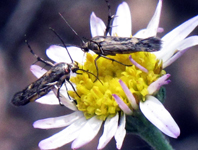Abstract
A new genus and species of epigean pseudoscorpions belonging to the subfamily Neobisiinae Chamberlin, 1930, is described from western Georgia and its diagnostic characters are illustrated. Cornuroncus n. gen. resembles the genus Roncus L. Koch, 1873 in several characters but differs by having a short dorso-distal spine on tarsus IV, and the presence of a ventral tooth on one of the claws of tarsus IV. An identification key for all valid Neobisiinae genera is provided.
References
Chamberlin, J.C. (1930) A synoptic classification of the false scorpions or chela-spinners, with a report on a cosmopolitan collection of the same. Part II. The Diplosphyronida (Arachnida-Chelonethida). Annals and Magazine of Natural History, Series 10, 5 (30), 585–620.
https://doi.org/10.1080/00222933008673173
Chamberlin, J.C. (1931) The arachnid order Chelonethida. Stanford University Publications, Biological Sciences, 7 (1), 1–284.
Ćurčić, B.P.M. (1975) Balkanoroncus (Arachnida, Pseudoscorpiones, Neobisiidae), a new genus of pseudoscorpions based on Roncus bureschi Hadži, 1939. Glasnik Muzeja Srpske Zemlje, Beograd, (B), 30, 143–145.
Ćurčić, B.P.M. (1987) Insulocreagris, a new genus of pseudoscorpions from the Balkan Peninsula (Pseudoscorpiones, Neobisiidae). Revue Arachnologique, 7, 47–57.
Gardini, G. (1982) Balkanoroncus baldensis n. sp. delle Prealpi Venete (Pseudoscorpionida, Neobisiidae) (Pseudoscorpioni d’Italia XIV). Bollettino del Museo Civico di Storia Naturale, Verona, 9, 161–173.
Gardini, G. (1998) Il genere Acanthocreagris in Italia (Pseudoscorpionida, Neobisiidae). Fragmenta Entomologica, 30, 1–73.
Harvey, M.S. (1992) The phylogeny and classification of the Pseudoscorpionida (Chelicerata: Arachnida). Invertebrate Taxonomy, 6, 1373–1435.
https://doi.org/10.1071/IT9921373
Harvey, M.S. (2013) Pseudoscorpions of the World. Version 3.0. Western Australian Museum, Perth. Available from: http://www.museum.wa.gov.au/catalogues/pseudoscorpions/ (accessed 17 January 2019)
Harvey, M.S. & Volschenk, E.S. (2007) The systematics of the Gondwanan pseudoscorpion family Hyidae (Pseudoscorpiones: Neobisioidea): new data and a revised phylogenetic hypothesis. Invertebrate Systematics, 21, 365–406.
https://doi.org/10.1071/IS05030
Harvey, M.S., Ratnaweera, P.B., Udagama, P.V. & Wijesinghe, M.R. (2012) A new species of the pseudoscorpion genus Megachernes (Pseudoscorpiones: Chernetidae) associated with a threatened Sri Lankan rainforest rodent, with a review of host associations of Megachernes. Journal of Natural History, 46, 2519–2535.
https://doi.org/10.1080/00222933.2012.707251
Hughes, G.B. & Moore, W. (2018) Monophyly of the subfamily Neobisiinae (Pseudoscorpiones: Neobisiidae). Journal of Arachnology, 46, 481–487
https://doi.org/10.1636/JoA-S-17-081.1
Judson, M.L.I. (2007) A new and endangered species of the pseudoscorpion genus Lagynochthonius from a cave in Vietnam, with notes on chelal morphology and the composition of the Tyrannochthoniini (Arachnida, Chelonethi, Chthoniidae). Zootaxa, 1627 (1), 53–68.
https://doi.org/10.11646/zootaxa.1627.1.4
Murienne, J., Harvey, M.S. & Giribet, G. (2008) First molecular phylogeny of the major clades of Pseudoscorpiones (Arthropoda: Chelicerata). Molecular Phylogenetics and Evolution, 49, 170–184.
https://doi.org/10.1016/j.ympev.2008.06.002
Zaragoza, J.A. (2008) On the status of the subspecies of Roncocreagris galeonuda (Pseudoscorpiones:Neobisiidae): importance of the chelal microsetae pattern. Remarks on the genus Roncocreagris Mahnert. Revista Ibérica de Aracnología, 15, 35–46.
Zaragoza, J.A. (2017) Revision of the Ephippiochthonius complex (Pseudoscorpiones, Chthoniidae) in the Iberian Peninsula, Balearic Islands and Macaronesia, with proposed changes to the status of the Chthonius subgenera. Zootaxa, 4246 (1), 1– 221.
https://doi.org/10.11646/zootaxa.4246.1.1

